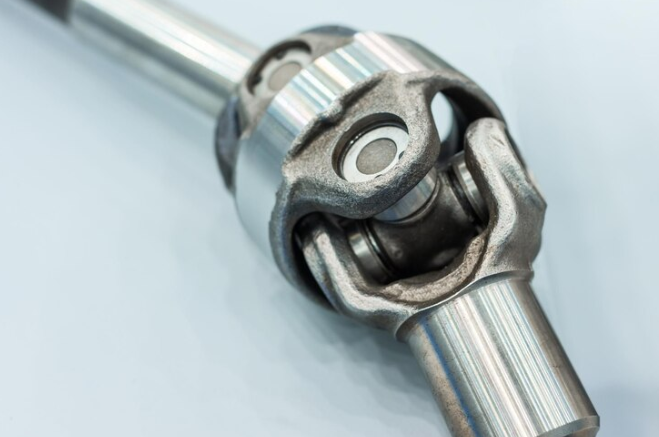Industrial universal joints are famously known as U-joints or universal couplings; they are essential parts in most mechanical systems, especially in situations requiring power to be transmitted between two shafts that are misaligned. These joints provide flexibility; their utility lies in the fact that connected shafts can rotate at different angles and yet transmit torque. Their design, reliability, and adaptability make them indispensable in so many heavy-duty industrial applications in manufacturing, automotive industries, agricultural production, and mining.
This article reveals information concerning the construction, working, advantages, and uses of industrial universal joints in current technological machinery.
Construction of an Industrial Universal Joint
Basically, the industrial universal joint consists of two yokes, a central cross or spider, and four needle bearings. Each of the shafts has the yokes mounted on it, and the central cross member provides the pivot point. The pivoting motion then gives the universal joint flexibility in transferring the rotational power between shafts that do not lie in a straight line with each other. The reduced friction and wear enable a smooth operation by the needle bearings located inside the joint.
Some industrial universal joints contain additional features, like hardened steel components, lubrication systems, and larger bearing surfaces, depending on the application, high-torque, or high-demand settings.
What is the Industrial Universal Joint?
The primary function of a universal joint is the transmission of rotational force between two misaligned shafts. Cross member rotates when the connected yoke moves with the input shaft rotation. This motion is transferred to the second yoke connected to the output shaft. The cross member enables the joint to bend and therefore accommodate any possible angular misalignments between the shafts.
In reality, however, due to the geometry of the universal joint, the output shaft does not rotate at constant velocity if the angle between the shafts is significant. This is called “non-uniform velocity,” or an alteration of speed in which one shaft rotates faster than the other. To minimize this, double U-joint systems are often used. This setup nullifies the velocity fluctuations thereby ensuring power transmission without interruptions.
Types of Industrial Universal Joints
Single U-Joint: The most basic type. A single U-joint is utilized where there is a less degree angle in which the shafts may be misaligned.
Double U-Joint: This setup involves two universal joints connected by an intermediate shaft. It is recommended where there is large misalignment, which minimizes velocity flapping hence used with complex machinery.
Constant Velocity (CV) Joint: Although not a universal joint in strict sense, a CV joint is designed to achieve constant velocity between input and output shafts, for which it is ideal in applications where accuracy is a requirement.
Applications of Industrial Universal Joints
- Automotive Industry: U-joints are used virtually throughout the drive train of a car to connect the transmission of the engine to the differential. Here, they allow the driveshaft to receive and transmit power as the suspension on a vehicle changes the angle between shafts.
- Heavy Machinery: Industrial U-joints apply especially for construction vehicles, earth movers, and cranes, where forces have to travel between mismatched shafts, which allows movement with flexibility. These heavy machinery that can work in harsh surroundings are therefore possible with the help of industrial U-joints assisting the provision of strength and reliability.
Manufacturing: Universal joints are used to transmit power from many parts of the machines within many different production machines, including conveyor systems and industrial robots. The universal joint is flexible and therefore absorbs misalignment and vibration so as to ensure a fluid process.
- Farm Equipment: Tractors, harvesters, as well as other farm machinery often employ universal joints to link several power systems, including the power take-off PTO shafts. U-joints are ideal for farm machinery due to their ability to sustain extremely rugged terrain and large angles of misalignment.
- Mining and Drilling: Universal joints are fitted on the mining machinery such as drill and excavators, which face maximum tensile stress along with severe operating conditions, hence strong and flexible attribute of universal joints is an essential requirement for carrying out power transmission efficiently in these challenging operating conditions.
Advantages of Using Industrial Universal Joints
- Flexibility: Universal joints’ U-joints permit the power to be transmitted between shafts that are not aligned, hence offering flexibility to machines that experience movement or angular shifts in their operation.
- Long-lasting: Made from high torque strength materials like hardened steel or an alloy, industrial U-joints are built to withstand heavy loads and have the strength of torque that ensures their reliability and longevity in harsh industrial environments.
- Economical: The universal joint is a simplified and robust way of dealing with misalignment in the machinery. Its form is less vulnerable to wear and tear, hence less costly keeping in mind long-term industrial applications.
- Versatility: There are various sizes and forms of universal joints being manufactured. This makes them productive in different types of industries and operations. In other words, the usage applied can be both light-duty and heavy-duty-type operations.
Conclusion
Universal joints for industrial purposes are very integral parts of the power transmission system in various industries. Being able to transfer torque between two misplaced shafts, their strength, and adaptability make them an essential part of heavy machinery and industrial works. With further progress, the design and efficiency of universal joints continue to excel and remain at the core of more complex mechanical systems across the globe.



